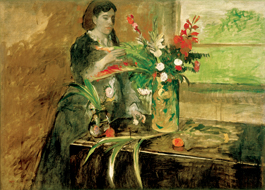home | metro silicon valley index | the arts | visual arts | review

Collection of New Orleans Museum of Art
STEM RESEARCH: Edgar Degas' 'Portrait of Estelle Musson De Gas' depicts the artist's sister-in-law arranging flowers.
Bend of The River
A new exhibit at the Cantor Arts Center showcases treasures from the New Orleans Museum of Art
By Michael S. Gant
HURRICANE KATRINA threatened but did not swamp the New Orleans Museum of Art, located on high ground in City Park. It did take great dedication by the staff to preserve the collection from the continuing danger of standing water in the basement. In the end, only one work in the outdoor sculpture garden was damaged. Still, the severe hit to the museum's budget and attendance has mirrored the pain felt throughout the New Orleans arts community.
To help signal its resilience, the museum is touring some of its collection, with a stop featuring more than 80 works at the Cantor Arts Center. The museum, founded in 1911, collects across the centuries and genres, with a concentration on French painters, befitting the city's heritage. The exhibit skips lightly over a wide range of styles; many are echoed in the Cantor's own permanent galleries upstairs.
French painter Claude Lorrain's large oil Ideal View of Tivoli (1644) presents a bucolic idyll at sunset in which rustic types gambol along with their cows beneath the famous ruins of the circular Temple of Vesta. The same mood of nostalgia permeates Sebastiano Ricci's Imaginary Scene With Ruins and Figures (circa 1725, with his grandson Marco). Visitors marvel at a courtyard of ancient statuary surrounded by walls with vegetation springing from the collapsing pediments. The Cantor owns two related works: Félix Boisselier's The Temple of Vesta offers a close-up of what we see at a distance in Lorrain; in Landscape With Ruins, an 18th-century piece by Francesco Guardi, trailing vines encase a disintegrating Roman arched wall.
Several examples of history painting are stage managed and static (Taillasson's Coriolanus Beseeched by His Mother and Wife—the title says it all), but real drama haunts Giovanni Martinelli's cautionary painting Death Comes to the Banquet Table (circa 1630). While a wedding party enjoys some sumptuously rendered fruits and desserts, a walking skeleton bearing an hourglass reaches for the groom, who turns in dismay—the bill has come due much too soon. In an era in which an early demise was commonplace, such memento mori were quite popular. Again, the Cantor has its own example: Franciscus Gysbrechts' Vanitas Still Life, with a human skull and an empty box making the point.
Edgar Degas spent a short but fruitful time in New Orleans, 1872–73, and the show includes one of his finest pieces from that time. In Portrait of Estelle Musson De Gas, the artist's sister-in-law carefully places cut flowers in a large vase. Her image seems to float out of an indistinct backdrop, pushing us to focus on her absorption in the task at hand.
The selection of Impressionists runs to a wintry palette, as opposed to the play of sunlight we usually associate with the movement: Claude Monet's Snow at Giverny finds the artist's favorite garden haunt almost entirely whited out. Camille Pissarro fills his canvas with pale sunlight on bare branches in Garden of the Tuileries in Winter (1900). Nearby is the startling contrast of the Fauvist Landscape at Cassis (1907) by André Derain, in which vibrant slashes of orange rooftops jump out from a dense field of round green treetops.
The 20th-century selections number a few serious pleasures. Joseph Cornell's Radar Astronomy (1952–56) box contains some of the American artist's favorite elements—a cork ball rolling on two metal rods, a white clay pipe, a green marble resting in a clear wine glass, a pasted-up backdrop of planetary orbits. The same basic building blocks are exquisitely reordered in the Cantor's own Cornell, Untitled (Constellation) .
San Francisco.com Real Estate
Moving to the Bay Area just became easy. Let San Francisco.com show you all the homes currently for sale.
San Jose.com Real Estate
Relocating to San Jose or Silicon Valley? Let San Jose.com introduce you to some expert area real estate agents.
Max Ernest's Everyone Here Speaks Latin (1943) is a prime example of the surrealist's later jungle paintings, and a modern take on Ricci and Boisselier. Pressing and blotting oil paint on the surface of his canvases, Ernst created postapocalyptic landscapes in which a fecund nature run wild engulfs what's left of human civilization. Tiny human figures seem to be tormented by the demons inhabiting the thick underbrush in a vision both unsettling and weirdly pastoral.
SPARED FROM THE STORM: MASTERWORKS FROM THE NEW ORLEANS MUSEUM OF ART shows through Oct. 5 at the Cantor Arts Center, Stanford. (650.725.0464)
Send a letter to the editor about this story.
|
|
|
|
|
|
